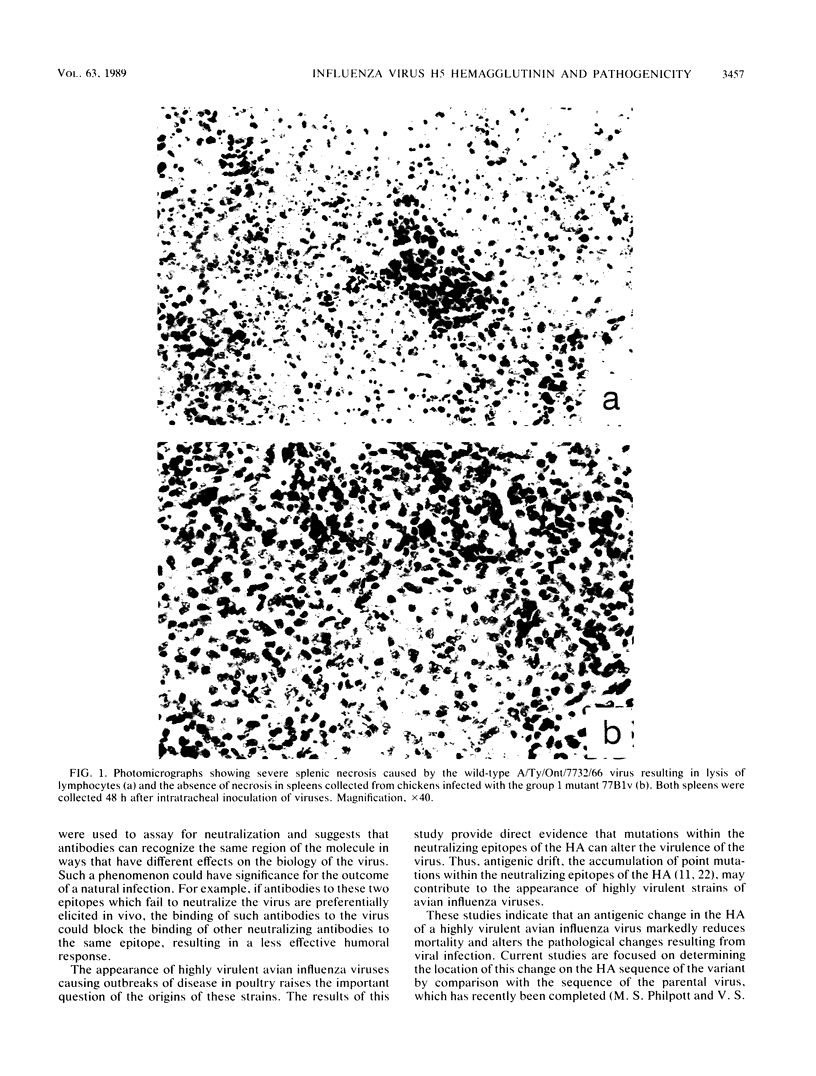Abstract
To define and characterize the major neutralizing epitopes of the H5 hemagglutinin, a panel of monoclonal antibodies specific for the H5 hemagglutinin of the virulent avian influenza virus A/Turkey/Ontario/7732/66 (H5N9) was prepared. Antibodies which neutralized infectivity of the virus were used to select a panel of escape mutants. Reactivity patterns of the panel of monoclonal antibodies against the panel of mutants by both enzyme-linked immunosorbent assay serology and hemagglutination inhibition operationally defined five distinct epitopes on the H5 molecule. The mutants were analyzed in vivo for virulence in chickens, and the findings indicate that viruses with mutations in four of five epitopes were no less virulent than the wild type, producing a rapidly fatal disease, while all viruses with mutations in the fifth epitope (group 1 mutants) were attenuated. These group 1 mutants were unaltered in the cleavage properties of the hemagglutinin, suggesting that the mechanism of attenuation is unrelated to processing of the hemagglutinin. One of the group 1 mutants, 77B1v, was characterized for its ability to produce necrosis of the spleen and was found to produce none of the lesions in the spleen which are characteristic of the wild-type virus, although virus was present in this organ. The results suggest an altered tissue tropism, perhaps sparing a population of cells critical to an effective immune response.
Full text
PDF





Images in this article
Selected References
These references are in PubMed. This may not be the complete list of references from this article.
- Bosch F. X., Garten W., Klenk H. D., Rott R. Proteolytic cleavage of influenza virus hemagglutinins: primary structure of the connecting peptide between HA1 and HA2 determines proteolytic cleavability and pathogenicity of Avian influenza viruses. Virology. 1981 Sep;113(2):725–735. doi: 10.1016/0042-6822(81)90201-4. [DOI] [PubMed] [Google Scholar]
- Bosch F. X., Orlich M., Klenk H. D., Rott R. The structure of the hemagglutinin, a determinant for the pathogenicity of influenza viruses. Virology. 1979 May;95(1):197–207. doi: 10.1016/0042-6822(79)90414-8. [DOI] [PubMed] [Google Scholar]
- Caton A. J., Brownlee G. G., Yewdell J. W., Gerhard W. The antigenic structure of the influenza virus A/PR/8/34 hemagglutinin (H1 subtype). Cell. 1982 Dec;31(2 Pt 1):417–427. doi: 10.1016/0092-8674(82)90135-0. [DOI] [PubMed] [Google Scholar]
- Deshpande K. L., Fried V. A., Ando M., Webster R. G. Glycosylation affects cleavage of an H5N2 influenza virus hemagglutinin and regulates virulence. Proc Natl Acad Sci U S A. 1987 Jan;84(1):36–40. doi: 10.1073/pnas.84.1.36. [DOI] [PMC free article] [PubMed] [Google Scholar]
- Gerhard W., Yewdell J., Frankel M. E., Webster R. Antigenic structure of influenza virus haemagglutinin defined by hybridoma antibodies. Nature. 1981 Apr 23;290(5808):713–717. doi: 10.1038/290713a0. [DOI] [PubMed] [Google Scholar]
- Kawaoka Y., Naeve C. W., Webster R. G. Is virulence of H5N2 influenza viruses in chickens associated with loss of carbohydrate from the hemagglutinin? Virology. 1984 Dec;139(2):303–316. doi: 10.1016/0042-6822(84)90376-3. [DOI] [PubMed] [Google Scholar]
- Kawaoka Y., Nestorowicz A., Alexander D. J., Webster R. G. Molecular analyses of the hemagglutinin genes of H5 influenza viruses: origin of a virulent turkey strain. Virology. 1987 May;158(1):218–227. doi: 10.1016/0042-6822(87)90256-x. [DOI] [PubMed] [Google Scholar]
- Kawaoka Y., Webster R. G. Sequence requirements for cleavage activation of influenza virus hemagglutinin expressed in mammalian cells. Proc Natl Acad Sci U S A. 1988 Jan;85(2):324–328. doi: 10.1073/pnas.85.2.324. [DOI] [PMC free article] [PubMed] [Google Scholar]
- Kida H., Brown L. E., Webster R. G. Biological activity of monoclonal antibodies to operationally defined antigenic regions on the hemagglutinin molecule of A/Seal/Massachusetts/1/80 (H7N7) influenza virus. Virology. 1982 Oct 15;122(1):38–47. doi: 10.1016/0042-6822(82)90375-0. [DOI] [PubMed] [Google Scholar]
- Lang G., Narayan O., Rouse B. T., Ferguson A. E., Connell M. C. A new influenza A virus infection in turkeys II. A highly pathogenic variant, a/turkey/ontario 772/66. Can Vet J. 1968 Jul;9(7):151–160. [PMC free article] [PubMed] [Google Scholar]
- Lubeck M. D., Gerhard W. Topological mapping antigenic sites on the influenza A/PR/8/34 virus hemagglutinin using monoclonal antibodies. Virology. 1981 Aug;113(1):64–72. doi: 10.1016/0042-6822(81)90136-7. [DOI] [PubMed] [Google Scholar]
- Narayan O. Pathogenesis of lethal influenza virus infection in turkeys. II. Central nervous system phase of infection. J Comp Pathol. 1972 Apr;82(2):139–146. doi: 10.1016/0021-9975(72)90055-2. [DOI] [PubMed] [Google Scholar]
- Narayan O., Thorsen J., Hulland T. J., Ankeli G., Joseph P. G. Pathogenesis of lethal influenza virus infection in turkeys. I. Extraneural phase of infection. J Comp Pathol. 1972 Apr;82(2):129–137. doi: 10.1016/0021-9975(72)90054-0. [DOI] [PubMed] [Google Scholar]
- Van Campen H., Easterday B. C., Hinshaw V. S. Destruction of lymphocytes by a virulent avian influenza A virus. J Gen Virol. 1989 Feb;70(Pt 2):467–472. doi: 10.1099/0022-1317-70-2-467. [DOI] [PubMed] [Google Scholar]
- Webster R. G., Kawaoka Y., Bean W. J., Jr Molecular changes in A/Chicken/Pennsylvania/83 (H5N2) influenza virus associated with acquisition of virulence. Virology. 1986 Mar;149(2):165–173. doi: 10.1016/0042-6822(86)90118-2. [DOI] [PubMed] [Google Scholar]
- Webster R. G., Laver W. G., Air G. M., Schild G. C. Molecular mechanisms of variation in influenza viruses. Nature. 1982 Mar 11;296(5853):115–121. doi: 10.1038/296115a0. [DOI] [PubMed] [Google Scholar]
- Webster R. G., Laver W. G. Determination of the number of nonoverlapping antigenic areas on Hong Kong (H3N2) influenza virus hemagglutinin with monoclonal antibodies and the selection of variants with potential epidemiological significance. Virology. 1980 Jul 15;104(1):139–148. doi: 10.1016/0042-6822(80)90372-4. [DOI] [PubMed] [Google Scholar]
- Wiley D. C., Wilson I. A., Skehel J. J. Structural identification of the antibody-binding sites of Hong Kong influenza haemagglutinin and their involvement in antigenic variation. Nature. 1981 Jan 29;289(5796):373–378. doi: 10.1038/289373a0. [DOI] [PubMed] [Google Scholar]
- Wilson I. A., Skehel J. J., Wiley D. C. Structure of the haemagglutinin membrane glycoprotein of influenza virus at 3 A resolution. Nature. 1981 Jan 29;289(5796):366–373. doi: 10.1038/289366a0. [DOI] [PubMed] [Google Scholar]



